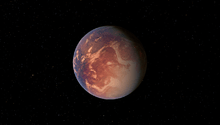Gliese 581 e
Gliese 581 e // or Gl 581 e is an extrasolar planet found around Gliese 581, a red dwarf star approximately 20.5 light-years away from Earth in the constellation of Libra. It is the third planet discovered in the system (fourth if the refuted planet candidate Gliese 581 d is included) and the first in order from the star.
The planet was discovered by an Observatory of Geneva team led by Michel Mayor, using the HARPS instrument on the European Southern Observatory 3.6 m (140 in) telescope in La Silla, Chile. The discovery was announced on 21 April 2009. Mayor's team employed the radial velocity technique, in which the orbit size and mass of a planet are determined based on the small perturbations it induces in its parent star's orbit via gravity.[2]

Artist concept of Gliese 581 e
At a minimum mass of 1.7 Earth masses,[1] it is one of the least-massive extrasolar planets discovered around a normal star, and relatively close in mass to Earth. At an orbital distance of just 0.03 AU (4,500,000 km) from its parent star, however, it orbits further in than the habitable zone. It is unlikely to possess an atmosphere due to its high temperature and strong radiation from the star. Although scientists think it probably has a rocky surface similar to Earth, it is also likely to experience intense tidal heating similar to (and likely more intense than) that affecting Jupiter's moon Io.[3] Gliese 581 e completes an orbit of its sun in approximately 3.15 days.[2][4][5]
See also
References
- ↑ 1.0 1.1 1.2 1.3 1.4 1.5 1.6 Robertson, Paul; Mahadevan, Suvrath; Endl, Michael; Roy, Arpita (3 July 2014). "Stellar activity masquerading as planets in the habitable zone of the M dwarf Gliese 581". Science (journal). arXiv:1407.1049. Bibcode:2014Sci...345..440R. doi:10.1126/science.1253253.
- ↑ 2.0 2.1 2.2 Mayor, M.; Bonfils, X.; Forveille, T.; Delfosse, X.; Udry, S.; Bertaux, J.-L.; Beust, H.; Bouchy, F. et al. (2009). "The HARPS search for southern extra-solar planets, XVIII. An Earth-mass planet in the GJ 581 planetary system". Astronomy and Astrophysics 507 (1): 487–494. arXiv:0906.2780. Bibcode:2009A&A...507..487M. doi:10.1051/0004-6361/200912172.
- ↑ Barnes, Rory; Jackson, Brian; Greenberg, Richard; Raymond, Sean N. (2009-06-09). "Tidal Limits to Planetary Habitability". The Astrophysical Journal 700: L30–L33. arXiv:0906.1785v1. Bibcode:2009ApJ...700L..30B. doi:10.1088/0004-637X/700/1/L30.
- ↑ Rincon, Paul; Amos, Jonathan (2009-04-21). "Lightest exoplanet is discovered". BBC. Retrieved 2009-04-21.
- ↑ Overbye, Dennis (April 21, 2009). "Astronomers Find Planet Closer to Size of Earth". New York Times.
External links
 Media related to Gliese 581 e at Wikimedia Commons
Media related to Gliese 581 e at Wikimedia Commons
 News related to Discovery of smallest exoplanet yields 'extraordinary' find at Wikinews
News related to Discovery of smallest exoplanet yields 'extraordinary' find at Wikinews
← Known celestial objects within 20–25 light-years → |
|---|
| | Celestial objects by systems. Secondary members are listed in small print. |
|---|
| | | | | | | | | | | | Italic are systems without known trigonometric parallax. |
|
|
|---|
| Events and
objects | |
|---|
| | Signals | |
|---|
| Extraterrestrial
bodies | |
|---|
| Planetary
habitability | |
|---|
| | Missions | |
|---|
| | Communication | |
|---|
| | Exhibitions | |
|---|
| | Hypotheses | |
|---|
| Related
topics | |
|---|
|
Coordinates:  15h 19m 26s, −07° 43′ 20″
15h 19m 26s, −07° 43′ 20″

![]() Media related to Gliese 581 e at Wikimedia Commons
Media related to Gliese 581 e at Wikimedia Commons
![]() News related to Discovery of smallest exoplanet yields 'extraordinary' find at Wikinews
News related to Discovery of smallest exoplanet yields 'extraordinary' find at Wikinews